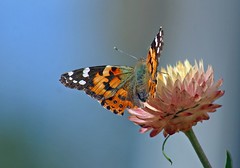Butterfly gardening is the art of using flowers and plants that attract butterflies to your home. The beautiful creatures will flutter through your garden, delighting and entertaining you. In return your flowers will provide a safe habitat and abundant food for them to enjoy. You add special importance to your flowers by using them in a butterfly garden.
What Flowers Should You Grow
It is important to find out what flowers and plants will attract butterflies in your area. Colorful flowers that are native to your area are a good first choice. Checking with your local greenhouses and gardening supply stores will help you to find what flowering plants are native to your home and will be the best attractors for butterflies.
If you cannot find local plants there are many types of flowers that grow in many environments and will attract a wide variety of butterflies. The aptly named Butterfly Weed and Butterfly Bush are two beautiful flowering plants that butterflies love. Asters, Daisies, and Marigolds are also easy to grow flowers that provide food and homes to many butterflies as they travel through. Flowers that have nectar rather than pollen will provide plenty of food for butterflies. Honeysuckle, lavender, and lilacs are beautiful nectar flowers that will enhance any garden.
Watering Your Butterflies
Butterflies need more than just flowers in your garden. A water source is just as important to caring for butterflies around your home. Water dishes should be shallow, clean, and kept high enough above the ground to discourage cats from attacking the fluttering creatures. Birdbaths are often good choices for butterflies, however a shallow dish hanging from a tree will also work well.
Be sure that their water is kept clean and free from stagnation. A butterfly water station also needs to be out of the direct sunlight to ensure it does not get too hot during the day. Placing it in a shaded area near your butterfly garden will make sure your butterflies can find water and quickly return to their safety.
When planting your butterfly garden you can add to the colors of your flowers by using a good layout. Flowers with warm red and orange tones looks best against a dark green background. Green ground vines or short grasses wold be a great background choice. Cooler blues and purples need a bright white background to help them stand out. Small white flowers such as the Greek yarrow or the Mountain sandwort would be a good background plants for your cooler toned flowers.
Creating a beautiful butterfly garden will enhance your home and bring hours of joy during the day as you watch the fluttering beauties travel by. By selecting plants that provide safety and food for butterflies, keeping water nearby, and staying out of their way you can fill your yard with color and elegance.








